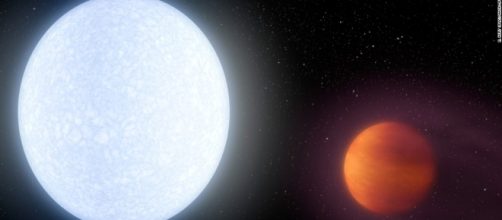A recently discovered exoplanet, named KELT-9b has been discovered and researchers have found that it is almost as hot as our sun according to MSN. However, this is not that first KELT named exoplanet in recent weeks that has fascinated researchers. Also, a Florida-based astronomer has finally figured out the origin behind Dr. Jerry Ehman's mysterious signal that has puzzled astronomers for the last forty years.
KELT-9b is a scorching hot planet
KELT-9b is another Jupiter-like exoplanet that has been discovered with a strange twist to it. The planet is tidally locked, which means that it's always showing the same face to its host star, named KELT-9, which is almost twice as hot as out sun. This means that the dayside face of KELT-9b reaches temperatures up to 7,800 degrees Fahrenheit (4,315 Celsius), which makes it only around 2,000 degrees cooler than our sun.
The study of KELT-9b was led by researchers from Ohio State and Vanderbilt Universities. Researchers initially found the planet back in 2014 using the Kilodegree Extremely Little Telescope-North telescope located in Arizona.
Researchers also found that the dayside face of the planet is being pummeled with stellar radiation and its temperatures are so high that carbon dioxide, methane and water are unable to form. This tidally locked, extremely hot dayside face makes the planet unlike anything that as been discovered. Researchers believe that the planet will eventually be engulfed, evaporated or boiled down due to the extreme heat and radiation it is taking on.
Ehman's signal solved
Back in August 1977, Dr.
Jerry Ehman spotted a mysterious signal during his search for extraterrestrial life. The signal was so strange that he wrote down "Wow" on his printout of the event and the mystery of its origin has alluded scientists for 40 years, until now. An astronomer from St. Petersburg College in Florida, Antonio Paris, says that the signal was nothing more than gas from the tails of two comets.
In his paper, Paris says that the frequency that Ehman heard was a naturally occurring event that comes from all comets. However, there is no data that suggests that the specific comets Paris studied are the ones that caused the signal back in 1977. Over a year-long period, Paris studied more than 200 observations in radio spectrum and comets. His found that the "Wow" signal, which has a frequency of 1420.25 MHz, was found in the gas that trailed certain comets.


